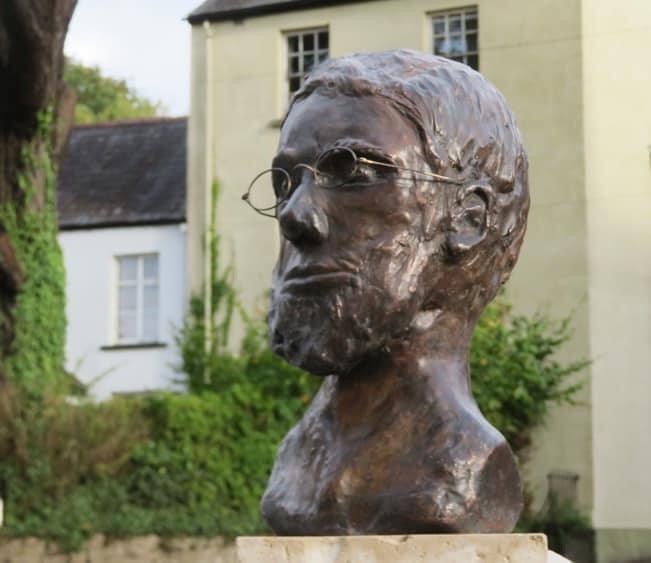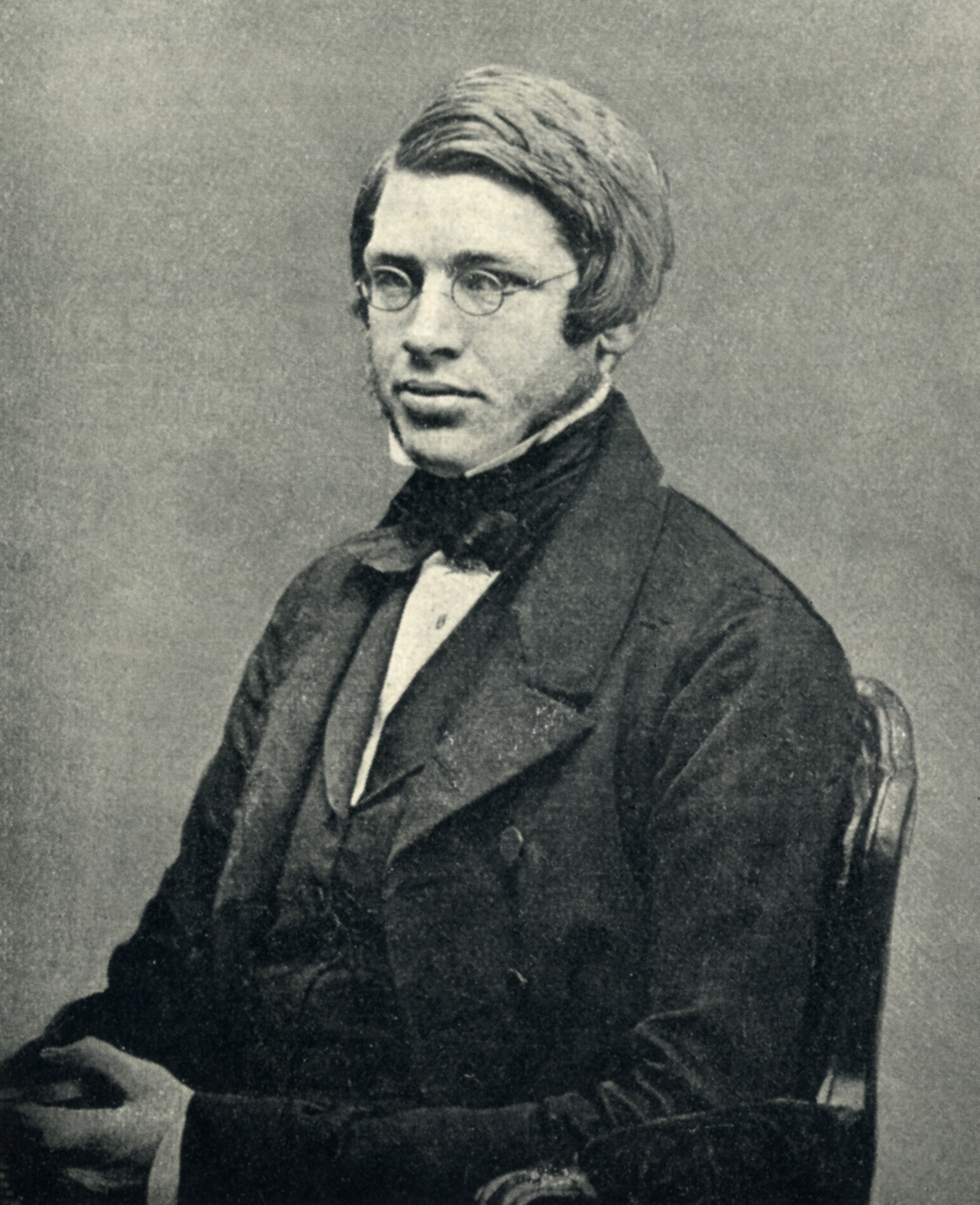 |
 |
On Saturday 6th November 2021, Usk will at last be able to pay a fitting tribute to one of her long-neglected sons – the great Usk born naturalist Alfred Russel Wallace (1823-1913), co- discoverer with Charles Darwin of the theory of evolution by natural selection. At 11.25 AM Bill Bailey, Patron of the Wallace Memorial Fund, alongside Dr George Beccaloni, Director of the Wallace Correspondence Project, will formally unveil a bronze bust of Wallace by Usk’s Felicity Crawley, who sculpted it based on the earliest surviving photograph of Wallace aged 25. (see above)
After some 7 years of planning and fundraising (and tortuous negotiations with the local authorities) by the Usk Civic Society, the bust has at last been erected in Twyn Square near the former HSBC bank, on a plinth of rare fossil-rich Portland Roach stone,
Usk Civic Society Chairman Tony Kear stated: “We are so delighted that such a World renowned naturalist and one of the greatest scientists of all time, has finally been formally recognised in his home town nearly 200 years after his birth. It’s been a long journey for Usk Civic Society, but we incredibly proud to have reached this milestone and are so delighted to have such distinguished guests in Bill Bailey and Dr George Beccaloni here today to unveil such a stunning bronze bust sculpted by a talented Usk resident Felicity Crawley.”
Dr Beccaloni commented “I am delighted that Usk has commemorated Wallace in such a prominent way. He is indeed one of the greatest scientists of all time and it is sad that so few remember that natural selection isn't just Darwin's theory, but Wallace's as well."
In his BBC series Bill Bailey remarked "I first heard about Wallace while I was trekking through the jungles of Indonesia 15 years ago and I've been fascinated by him ever since. This geeky Victorian collector changed our understanding of life on Earth. Along with Charles Darwin, he came up with one of the greatest scientific ideas of all time: the theory of evolution by natural selection. These two men independently came up with the same explosive theory, but now, a hundred years on, Wallace has been forgotten. I guess you could say he's the Missing Link in the story of evolution."
The bust will be formally unveiled on Saturday 6 November, beginning at 11.15am. The approximate running order of the proceedings is:
11.15 am onwards: Town Band to play
11.25 am: Tony Kear as Chairman of UCS will introduce Felicity Crawley (sculptor) and Dr George Beccaloni, Director of the Wallace Correspondence Project and Chairman of the Wallace Memorial Fund.
11.30 am: George Beccaloni will talk on Wallace and Usk and introduce Bill Bailey, who will unveil the bust and plinth
11.40 am: Presentations by the Chairman to Felicity Crawley, George Beccaloni and Bill Bailey From 11.45 am there will be a chance to view the newly revealed bust and plinth and information board.
We are delighted that Bill Bailey, a great advocate for Wallace and Patron of the Wallace Correspondence Project and Memorial Fund, has been able to find time from his busy schedule to attend.
Background
Wallace was born in Kensington Cottage, just across the river between Usk and Llanbadoc. He had 8 siblings, and two of his sisters, who died in infancy, are buried in Llanbadoc Churchyard. The young Wallace, as he recalls in his autobiography, used to fish for lampreys in the Usk and would often play with friends in the ruins of Usk Castle.
Wallace's main claim to fame lies in his work on evolutionary biology. Whilst living in Neath in 1845 he became fascinated by the then heretical idea of evolution. He set off to try and understand it and discover how it works by forming a large collection of biological specimens, first in the Amazon region of South America, and then in what he called the Malay Archipelago (now Singapore, Malaysia, Indonesia and East Timor). In 1858 half way through his Malay expedition he finally discovered the mechanism he had been searching for for 10 years: natural selection. He wrote an essay explaining his theory and posted it together with a covering letter to Charles Darwin from the Spice Island of Ternate in what is now Indonesia. Little did he know that Darwin had been secretly working on the same theory for 20 years. Wallace's essay, along with some hastily assembled notes written by Darwin, were published by London's Linnean Society in August 1858 as the paper "On the tendency of species to form varieties; and on the perpetuation of varieties and species by natural means of selection." [See https://wallacefund.myspecies.info/content/1858-darwin-wallace-paper] This event spurred Darwin to write his famous book Origin of Species, which was published 15 months later in 1859. Few today remember that the theory was jointly published by both men and erroneously believe it originated (!) in Darwin's book.
Until the early 20th century, evolution was widely known as the "Darwin-Wallace Theory", but since then Wallace's pivotal role in the discovery has been progressively forgotten. [A recent BBC series, Bill Bailey's Jungle Hero, has done much to re-establish public awareness of Wallace's part in the story of evolutionary theory and can be watched on BBC iPlayer at this link: https://www.bbc.co.uk/iplayer/episode/p0160p0s/bill-baileys-jungle-hero-1- wallace-in-borneo].
Wallace's long and varied life saw him make seminal contributions to other areas of science [see https://wallacefund.myspecies.info/content/scientific-legacy], as well as to a wide variety of social causes. His contribution to biogeography remains outstanding and the "Wallace Line" that separates the fauna of south Asia from the radically different fauna of Australasia commemorates his huge insights in this area. He also campaigned for land and social reform and made surprising contributions to many other fields: for example, economics (he was the first to propose a cost of living index) and astronomy, where he brought scientific rationality to bear on the then widely-accepted idea that there were canals on Mars created by Martians. The award of the Order of Merit, late in his long life, recognised his status worldwide. Wallace was a prodigious writer and receiver of letters and Dr Beccaloni's Wallace Correspondence Project [see https://wallaceletters.myspecies.info] has been working to locate, digitise, catalogue, transcribe, interpret and publish his surviving correspondence.
Notes to the Editors
Alfred Russel Wallace was born in Kensington Cottage, Llanbadoc, Usk in 1823 and lived there until the family moved to Hertford when he was five. In his autobiography My Life he tells of his early memories of playing on the rocks in the River Usk and catching lampreys. Wallace was self-taught and worked variously as an apprentice builder, watchmaker, surveyor and teacher. While living with his brother in London he attended lectures on Owenism which were to influence him many years later. Teaching at Leicester he met Bates, an enthusiastic collector of beetles, who stimulated Wallace’s interest in natural history. Then, while working with his brother as a surveyor for railways and tithes in the Neath valley he developed a keen interest in the geographical distribution of species.
Wallace embarked on two major expeditions as a collector, sending specimens to museums and private collectors back home. The first expedition, at the age of twenty-five, was to the Amazon with his friend Bates. Bates concentrated on the Amazon, Wallace on the Rio Negro. Wallace’s younger brother Herbert joined him but unfortunately die of a fever. His four years in the Amazon Basin were very productive but, tragically, his ship sank on the way home and all his specimens and most of his notebooks were lost. His account of this voyage A Narrative of Travels on the Amazon was published in 1853.
With typical resilience Wallace embarked on a second expedition in 1854 which was to turn out to be the most important event of his life. Wallace turned eastwards to the Malay Archipelago in search of, among other things, the Bird of Paradise and the Orang-utan. He described his journeys from island to island in his highly successful and readable book The Malay Archipelago (1869). Along with this literary success there were two important scientific ones. The first and most well-known achievement was his discovery, independently of Darwin, of the principle of natural selection. As is well-known, he sent an account of his discovery to Darwin to the latter’s great discomfiture. Contributions from each were published in a joint paper by the Linnean Society in 1858 and Wallace’s essay stimulated Darwin into writing The Origin of Species. The new and controversial explanation of evolution became known as the Darwin-Wallace theory.
The other, less well-known, discovery arose from Wallace’s interest in biogeography. He noticed a sharp divide between Asian and Australasian species along what is still known as the Wallace Line. For Wallace the processes of natural selection and of the geographical distribution of species were inseparable.
Wallace and Darwin maintained friendly scientific contact in defence of their joint theory. Indeed Wallace called his big book on evolution Darwinism (1869). However, they came to differ on sexual selection and the higher stages of human evolution. Wallace continued to publish scientific work and, living to the age of ninety, became a “grand old man” of science. He was awarded the Gold Medal of the Linnean Society and the Order of Merit.
Although principally known as an evolutionary biologist Wallace became a vigorous campaigner about the issues he believed in, including spiritualism (pro) and compulsory- vaccination (anti). Most importantly he campaigned for land nationalisation and became a socialist and anti-imperialist. He died in 1913 at the age of ninety.
Enquiries to Tony Kear Chairman Usk Civic Society 07824810182
